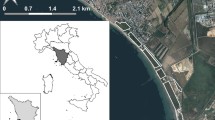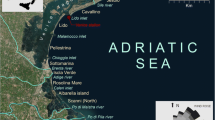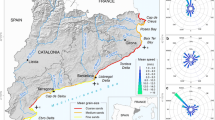Abstract
The aim of this work is to identify habitats of European interest for the existing dunes in the Canaries, in order to provide data for their proper management. Dune systems considered were the following: aeolian sedimentary systems that cover both most of the island of La Graciosa and also the dune fields of Maspalomas (Gran Canaria) and Corralejo (Fuerteventura). The methodology consisted of overlapping layers of habitats and vegetation by using geographic information systems, so the correspondence between habitat and plant community are analyzed. The results indicate that dune habitats in the Canary Islands have not been well defined. The habitat “2110 embryonic shifting dunes” is associated with several situations incompatible with their biotic and abiotic characteristics. Meanwhile, habitat “2130 fixed dunes with herbaceous vegetation (grey dunes)” is linked, among others, to the phytosociological association Traganetum moquinii. However, embryonic dune formation in the Canaries is mainly done by this community, which is inconsistent with its inclusion in the grey dunes habitat. The proposed habitats of European interest associated with dunes in the Canaries are the following: Coastal shifting dunes with Traganum moquinii, dunes with Tamarix canariensis, Macaronesian aeolian sand sheets and humid dune slacks. It is also suggested the need for a comprehensive study of dune habitats existing in the Canaries and Macaronesia, covering the whole of aeolian sedimentary systems, performing a proper identification, characterization and detailed mapping of these habitats, based on both the existing vegetation and also on the associated landforms and geomorphic processes.








Similar content being viewed by others
References
Alonso I, Hernández L, Alcántara-Carrió J, Cabrera L, Yanes A (2011) Los grandes campos de dunas actuales de Canarias. In: Sanjaume Saumell E, Gracia Prieto FJ (eds) Las dunas en España. Sociedad Española de Geomorfología, Cádiz, pp 467–496
Barrett-Mold C, Burningham H (2010) Contrasting ecology of prograding coastal dunes on the northwest coast of Ireland. J Coast Conserv 14:81–90
Cabrera LL, Hernández-Cordero AI, Viera M, Cruz N, Hernández-Calvento L (2013) Caracterización de una duna costera de zona árida: Maspalomas (Gran Canaria). Geo-Temas 14:107–110
Cabrera-Vega LL, Cruz-Avero N, Hernández-Calvento L, Hernández-Cordero AI, Fernández-Cabrera E (2013) Morphological changes in dunes as an indicator of anthropogenic interferences in arid dune fields. J Coast Res Spec Issue 65:1271–1276
Corenblit D, Baas ACW, Bornette G, Darrozes J, Delmotte S, Francis RA, Gurnell AM, Julien F, Naiman RJ, Steiger J (2011) Feedbacks between geomorphology and biota controlling earth surface processes and landforms: a review of foundation concepts and current understandings. Earth-Sci Rev 106:307–331
Costa JC, Neto C, Aguiar C, Capelo J, Espirito Santo MD, Honrado J, Pinto-Gomes C, Monteiro-Henriques T, Sequeira M, Lousa M (2012) Vascular plant communties in Portugal (continental, The Azores and Madeira). Glob Geobotany 2:1–180
Cowles HC (1899a) The ecological relations of the vegetation on the sand dunes of Lake Michigan. Bot Gaz 27(3):167–202
Cowles HC (1899b) The ecological relations of the vegetation on the sand dunes of Lake Michigan. Bot Gaz 27(5):361–391
Cruz Avero N, Fernández Cabrera E, Fernández Negrín E, Hernández Calvento L, Hernández Cordero A, Mangas Viñuela J, Máyer Suárez P, Pérez-Chacón Espino E, Romero Martín L (2009) Unidades ambientales del campo de dunas de Corralejo, Fuerteventura (Islas Canarias). Estudio preliminar. XIV Jornadas de estudios sobre Lanzarote y Fuerteventura
Gobierno de Canarias (2001) Hábitats de interés comunitario presentes en Canarias acorde a la Directiva 92/43/CEE y al RD 1997/1995. Consejería de Política Territorial y Medio Ambiente, Viceconsejería de Medio Ambiente, Dirección General de Política Ambiental
Del Arco MJ (ed) (2006) Mapa de vegetación de Canarias. GRAFCAN Ediciones, Santa Cruz de Tenerife
Del Arco Aguilar MJ, González-González R, Garzón-Machado V, Pizarro-Hernández B (2010) Actual and potential natural vegetation on the Canary Islands and its conservation status. Biodivers Conserv 19:3089–3140
Doody JP (ed) (1991) Sand dune inventory of Europe. Joint Nature Conservation Committee/European Union for Coastal Conservation, Peterborough
European Commission (2007) Interpretation manual of European Union habitats. EUR 27, DG-Environment
Evans D (2006) The habitats of the european union habitats directive. Biol Environ 106B(3):167–173
Evans D (2010) Interpretation the habitats of Annex I: past, present and futures. Acta Bot Gallica 157(4):677–686
Feola S, Carranza ML, Schaminée JHJ, Janssen JAM, Acosta ATR (2011) EU habitats of interest: an insight into Atlantic and Mediterranean beach and foredunes. Biodivers Conserv 20:1457–1468
Fernández-Cabrera E, Pérez-Chacón E, Cruz Avero N, Hernández-Cordero A, Hernández-Calvento L (2011) Consecuencias ambientales del crecimiento urbano-turístico en el sistema de dunas de Corralejo (Fuerteventura-Islas Canarias). In: Gozálvez Pérez V, Marco Molina JA (eds) Urbanismo expansivo de la utopía a la realidad. Asociación de Geógrafos Españoles, Colegio de Geógrafos de España, Universidad de Alicante, Alicante, pp 241–252
García Becerra R, Peña Estévez MA (1995) Contribución al conocimiento de la fauna coleopterológica en los ecosistemas dunares de gran canaria (islas Canarias). Anuario de Estudios Atlánticos 41:17–37
García-Madrid A, Molina JA, Cantó P (2014) Classification of habitats highlights priorities for conservation policies: the case of Spanish Mediterranean tall humid herb grasslands. J Nat Conserv 22:142–156
Géhu JM, Biondi E (1996) Apport à la connaissance de la végétation du littoral marocain sud-occidental: Les communautés végétales psammophiles des dunes et placages sableux du Maroc macaronésien. B Soc Bot Cent-Ouest 27:179–214
Géhu JM, Biondi E (1998) Nature et limites de quelques végétations littorales de type macaronésien sur les còtes sud occidentales du Maroc. Acta Bot Barc 45:439–453, Homenatge a Oriol de Bolòs
Gracia FJ, Sanjaume E, Hernández-Calvento L, Hernández-Cordero AI, Flor G, Gómez-Serrano MA (2009) 2 Dunas marítimas y continentales. In: VV.AA Bases ecológicas preliminares para la conservación de los tipos de hábitat de interés comunitario en España. Ministerio de Medio Ambiente, y Medio Rural y Marino, Madrid
Gutiérrez-Elorza M, Lucha P, Gracia FJ, Desir G, Marín C, Petit-Maire N (2013) Palaeoclimatic considerations of talus flatirons and aeolian deposits in Northern Fuerteventura volcanic island (Canary Islands, Spain). Geomorphology 197:1–9
Hernández Calvento L, Alonso Bilbao I, Hernández Cordero AI, Pérez-Chacón Espino E, Yanes Luque A, Cabrera Vega L (2009) Características propias de los sistemas eólicos actuales de Canarias. Notas preliminares. In: Morales JA, Cantano M, Rodríguez-Ramírez A, Delgado I (eds) Nuevas contribuciones sobre geomorfología litoral. Universidad de Huelva, Sociedad Geológica de España, Sociedad Española de Geomorfología, Huelva, pp 39–43
Hernández-Cordero AI, Pérez-Chacón Espino E, Hernández-Calvento L (2012) La investigación como soporte de la gestión: el ejemplo de la duna costera (foredune) de Maspalomas (Gran Canaria, Islas Canarias). In: Rodríguez-Perea A, Pons GX, Roig-Munar FX, Martín-Prieto JA, Mir-Gual M, Cabrera JA (eds) La gestión integrada de playas y dunas: experiencias en Latinoamérica y Europa, Monografies de la Societat d’Història Natural de les Balears 19. Palma de Mallorca, Spain, pp 289–306
Hernández-Cordero AI, Pérez-Chacón Espino E, Hernández-Calvento L (2015a) Vegetation, distance to the coast, and aeolian geomorphic processes and landforms in a transgressive arid coastal dune system. Phys Geogr 36(1):60–83
Hernández-Cordero AI, Hernández-Calvento L, Pérez-Chacón Espino E (2015b) Relationship between vegetation dynamics with dune mobility in an arid transgressive coastal system, Maspalomas, Canary Islands. Geomorphology 238:160–176
Heslenfeld P, Jungerius PD, Klijn JA (2004) European coastal dunes: ecological values, threats, opportunities and policy development. In: Martínez ML, Psuty NP (eds) Coastal dunes. Ecology and conservation, ecological studies, vol 171. Springer, Berlin, pp 335–351
Hesp PA (2002) Foredunes and blowout: initiation, geomorphology and dynamics. Geomorphology 48:245–268
Houston J (2008) Management of Natura 2000 habitats. 2130 *Fixed coastal dunes with herbaceous vegetation (‘grey dunes’). European Commission
Martins MC, Neto CS, Costa JC (2013) The meaning of mainland Portugal beaches and dunes’ psammophilic plant communities: a contribution to tourism management and nature conservation. J Coast Conserv 17:279–299
Médail F, Quézel P (1999) The phytogeographical significance of S.W. Morocco compared to the Canary Islands. Plant Ecol 140:221–244
Moss D, Davies CE (2002) European topic centre on nature protection and biodiversity EUNIS habitat classification 2001 work programme. Cross-references between the EUNIS habitat classification and the Palaearctic habitat classification, European Environment Agency, Centre for Ecology and Hydrology
Nerilli G, Naranjo A, Fernández-Palacios JM (2011) Los ecosistemas macaronésicos. In: Montes C, Gómez Sal A (eds) Evaluación del Milenio en España. Fundación Biodiversidad. Ministerio de Medio Ambiente, Rural y Marino, Madrid, pp 895–980
Parker K, Bendix J (1996) Landscape-scale geomorphic influences on vegetation patterns in four environments. Phys Geogr 17:113–141
Pérez-Chacón E, Hernández-Calvento L, Fernández Negrín E, Romero L, Máyer P, Hernández Cordero A, Cruz N, Fernández Cabrera E, Peña C, Corbalán Y, Mangas J, Alonso I, Rodríguez S, Sánchez I, Cabrera L (2010) Caracterización del sistema sedimentario eólico de La Graciosa (archipiélago Canario). Informe final. Centro “Isla de La Graciosa” (OAPN-Ministerio de MAMRM), ULPGC, Las Palmas de Gran Canaria
Pérez-Chacón E, Hernández-Calvento L, Fernández-Negrín E, Máyer P, Hernández-Cordero A, Cabrera L, Cruz N, Fernández-Cabrera E, García Romero L, Peña C, Santana A, Mangas J, Rodríguez S (2012) Evolución reciente del sistema sedimentario eólico de La Graciosa (archipiélago Canario): claves para su diagnóstico ambiental. Informe final. Centro “Isla de La Graciosa” (OAPN-Ministerio de Agricultura, Alimentación y Medio Ambiente), ULPGC, Las Palmas de Gran Canaria
Ranwell D (1960) Newborough Warren, Anglesey: II. Plant associes and succession cycles of the sand dune and dune slack vegetation. J Ecol 48(1):117–141
Santos A (1993) Dry coastal ecosystems of the Canary Islands and the Ilhas Selvagens. In: van der Maarel E (ed) Ecosystems of the World 2B: dry coastal ecosystems (Africa, America, Asia and Oceania). Elsevier, Amsterdam, pp 51–57
Stallins JA (2006) Geomorphology and ecology: unifying themes for complex systems in biogeomorphology. Geomorphology 77:207–216
Sunding P (1972) The vegetation of Gran Canaria. Skr. Norske Vidensk. Akal., Oslo. I. Mate.-Naturv. Kl., Suplemment 29
Swanson FJ, Kratz TK, Caine N, Woodmansee RG (1988) Landform effects on ecosystem patterns and processes. Bioscience 38(2):92–98
Acknowledgments
This research has been made possible thanks to the funding of the Organismo Autónomo Parques Nacionales (the “Isla de La Graciosa” centre), of the Spanish National Ministry for Agriculture, Food and the Environment, managed by the ULPGC through the University Foundation of Las Palmas (FULP), as well as REN2003-05947, SEJ2007-64959, CSO2010-18150 and CSO2013-43256-R projects of the Spanish National Plan for R + D + i (innovation), co-financed with ERDF funds.
Author information
Authors and Affiliations
Corresponding author
Rights and permissions
About this article
Cite this article
Hernández-Cordero, A.I., Gracia Prieto, F.J., Hernández-Calvento, L. et al. Proposal for new EU habitats associated with coastal dune fields of the Macaronesian region. A case study in the Canary Islands (Spain). J Coast Conserv 19, 213–225 (2015). https://doi.org/10.1007/s11852-015-0382-z
Received:
Revised:
Accepted:
Published:
Issue Date:
DOI: https://doi.org/10.1007/s11852-015-0382-z




